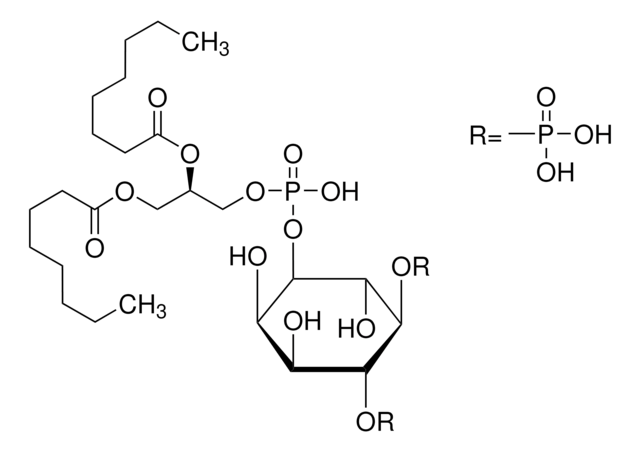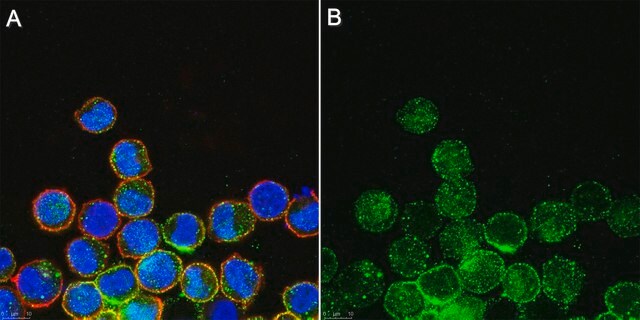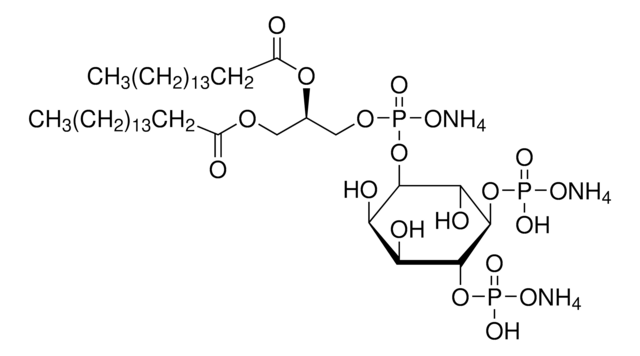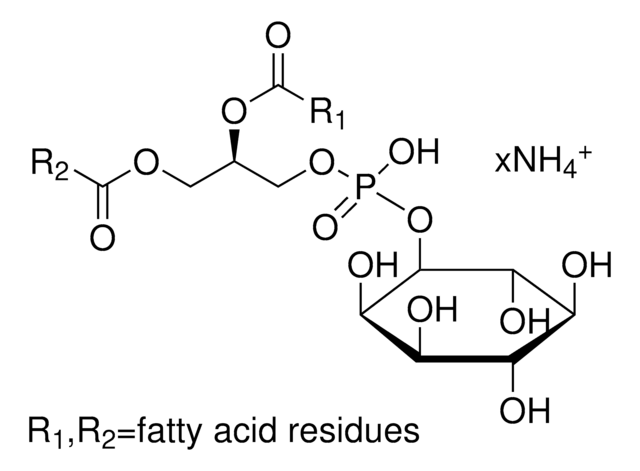524644
L-α-Phosphatidyl-D-myo-inositol-4,5-bisphosphate, Triammonium Salt, Porcine Brain
A component of membrane-bound receptors in association with phospholipase C (PLC).
Synonym(s):
L-α-Phosphatidyl-D-myo-inositol-4,5-bisphosphate, Triammonium Salt, Porcine Brain, PIP₂
About This Item
Recommended Products
Quality Level
Assay
≥98% (TLC)
form
solid
manufacturer/tradename
Calbiochem®
storage condition
OK to freeze
desiccated (hygroscopic)
protect from light
color
white to off-white
solubility
water: 10 mg/mL
chloroform: 50 mg/mL
shipped in
wet ice
storage temp.
−70°C
SMILES string
[P](=O)(O[C@@H]1C([C@@H](C(C(C1O)O[P](=O)(O)O)O[P](=O)(O)O)O)O)(OC[C@H](OC(=O)CCC\C=C/C\C=C/C\C=C/C\C=C/CCCCC)COC(=O)CCCCCCCCCCCCCCCCC)O.N.N.N
InChI
1S/C47H85O19P3.3H3N/c1-3-5-7-9-11-13-15-17-19-20-22-24-26-28-30-32-34-36-41(49)63-39(37-61-40(48)35-33-31-29-27-25-23-21-18-16-14-12-10-8-6-4-2)38-62-69(59,60)66-45-42(50)43(51)46(64-67(53,54)55)47(44(45)52)65-68(56,57)58;;;/h11,13,17,19,22,24,28,30,39,42-47,50-52H,3-10,12,14-16,18,20-21,23,25-27,29,31-38H2,1-2H3,(H,59,60)(H2,53,54,55)(H2,56,57,58);3*1H3/b13-11-,19-17-,24-22-,30-28-;;;/t39-,42?,43+,44?,45-,46?,47?;;;/m1.../s1
InChI key
GAIOWTITBYPFJE-JVILRMJCSA-N
General description
Note: This product is not to be used for animal treatment, in vivo research or in any other contact procedure with livestock.
Biochem/physiol Actions
Brain phospholipase D (PLD)
Packaging
Warning
Reconstitution
Other Notes
Shyng, S.-L., and Nichols, C.G. 1998. Science 282, 1138.
Mazzotti, G., et al. 1995. J. Histochem. Cytochem. 43, 181.
Liscovitch, M., et al. 1994. J. Biol. Chem. 269, 21403.
Chauhan, A., et al. 1991. Biochem. Biophys. Res. Commun. 175, 852.
Williamson, J.R. 1986. Hypertension 8, 140.
Berridge, M.J., and Irvine, R.F. 1984. Nature312, 315.
Legal Information
Storage Class Code
11 - Combustible Solids
WGK
WGK 3
Flash Point(F)
Not applicable
Flash Point(C)
Not applicable
Certificates of Analysis (COA)
Search for Certificates of Analysis (COA) by entering the products Lot/Batch Number. Lot and Batch Numbers can be found on a product’s label following the words ‘Lot’ or ‘Batch’.
Already Own This Product?
Find documentation for the products that you have recently purchased in the Document Library.
Our team of scientists has experience in all areas of research including Life Science, Material Science, Chemical Synthesis, Chromatography, Analytical and many others.
Contact Technical Service








